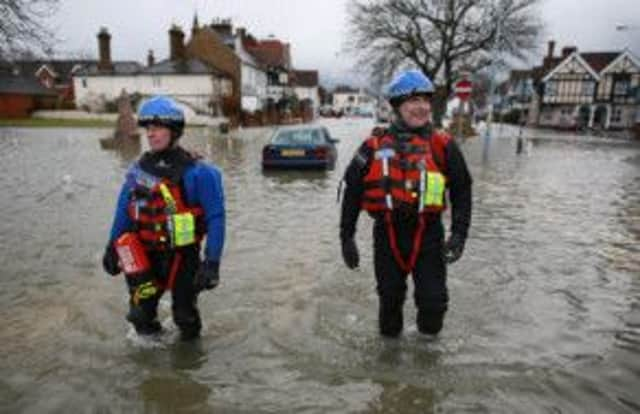Bill Jamieson: UK battered by incoming flood bill


Retail sales growth was the strongest in four years, recovery was broadening out and the budget deficit was coming in below forecast.
But all those optimistic pointers have been blown out of sight by the worst storms to hit Britain for 250 years. Now fearful estimates are coming in for the repair bill.
Advertisement
Hide AdAdvertisement
Hide AdAccountancy firm PwC estimates the damage in December and January alone will generate catastrophic insurance claims from flood and weather-hit households of £500 million, while infrastructure repairs and flood containment programmes could drive this total to £630m. Even this figure, it warned, was likely to rise were the storms to continue into February (they did, and got worse), meaning the overall impact could be close to £1 billion.
That may be just the start of it. Richard Holt, of Capital Economics, calculates that the geographical area currently at risk – extending into the heartland of the Thames Valley, M4 and M3 corridors – accounts for perhaps 13 per cent of UK GDP. An economic impact there will certainly be, and when the UK’s economic recovery is not yet secure. This has led to lurid figures being bandied about of an overall economic impact extending to £14bn.
Previous bad weather costs reveal a wide variation in impact. The blizzards in the fourth quarter of 2010 were reckoned by the Office for National Statistics to have hit GDP by 0.5 per cent. But it added that part of the shortfall was regained in the following quarter. People undertook trips previously postponed, made purchases they had delayed, and factories, offices and construction sites quickly made up some of the lost output.
More recently, in 2012, the UK experienced widespread flooding. Many parts of the country were affected, although not with anything like the current severity. At the time, says Capital Economics, estimates of the insurance cost varied from £0.5bn to £1.4bn.
The Prime Minister has already ordered the Environment Agency to dredge the Somerset rivers and has pledged another £100m to improve flood defences – this on top of £300m to be found by 2016.
But looking at the widespread damage to coastlines and road and rail links across the Midlands and southern England, these sums are likely to fall well short of the repair work now required. It is against this background that David Cameron’s declaration last week that “money is no object” and that the government would do “whatever it takes” sent eyebrows shooting up.
For the past four years, the government has been labouring under a debt pile now at £1.2bn and rising. It’s because money has been a problem that we are now facing a colossal bill for repairs and rebuilding of key infrastructure. “Savings and efficiencies” – those rhetorical ghostly apparitions that have haunted modern political vocabulary – have more often than not been found by cutting not bureaucracy and top-heavy head offices but those invisible maintenance programmes that voters do not readily miss… until now. Economies achieved by this route have now been exposed as false.
In a “high-vis” political culture, how much more voter-attractive, surely, are those bright, shiny, new initiatives so beloved of both government and opposition parties. How long would a local council survive were it to turn round and say: “Money? We’ve spent it on the drains.”
Advertisement
Hide AdAdvertisement
Hide AdNow we have been brought, sodden and soaked, to a moment of truth: that there is much in the business of government that is unglamorous and unsexy and does not make for voter-enticing headlines. Much of basic local government is invisible – that is, until the bins aren’t collected or the street lights don’t come on or the roads are flooded.
An immediate worry for the Treasury is that Cameron’s statement may have ignited public expectation that the government will fork out for every ruined carpet and spongy sofa. Little wonder that Chief Whip Sir George Young issued a “no blank cheque” note to backbenchers clarifying what the government means.
And the Treasury has sent signals indicating that much of the money for flood and storm damage will have to come from within existing budgets. In other words, more cuts will need to be made elsewhere.
However, I would be surprised if this year’s spring Budget does not see the Treasury purses opened rather wider than Cameron has already indicated. Local authorities now have a powerful case for extra support from central government.
And it is here that this massive repair bill could in time prove more of a help than a hindrance to economic recovery. Contrary to popular assumption, economists have often argued that natural disasters can work as much as a stimulant as a wealth-destroyer.
There’s the immediate stimulus provided by higher government expenditure. And there are longer-term benefits set to accrue from infrastructure improvement. With new technology and state-of-the-art equipment, road and rail travel times could prove to be faster and/or connectivity could improve, providing a productivity benefit.
That will be cold comfort to many in the immediate aftermath of the storms. But equally it would be wrong to view all this as an unmitigated economic setback once the repair budgets start to be spent. «